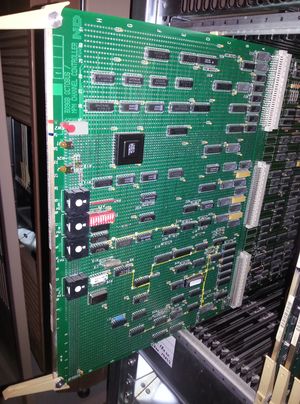OCTOBUS
Octobus (or OCTObus, as it was written in some documentation) was a high-speed serial command bus for system-internal high speed signal/command transfer. It could send short messages used for synchronization of directly coupled processors in multi-processor configurations including DOMINO I/O controllers.

Purpose
Octobus was a part of transforming the original ND-500 design, where the ND-110 processor was an I/O bottleneck, to a multi-processor system with DOMINO I/O boards connected directly to the MF-Bus. The role of OCTObus was to manage and synchronize the processors.
Physical implementation
The MPM-5 (MultiPortMemory) system was extended with the physical wiring and features for Octobus support and was then called Multi-Function bus, or MF-Bus, introduced with the ND-5000 series.
Protocol overview
- An OCTObus message is 32 bits. It includes priority, destination, source, information, etc.
- Each device connected to the OCTObus is called a node.
- There can be up to 62 nodes on one OCTObus.
- An OCTObus can be bridged to another OCTObus if 62 nodes isn't sufficient.
- One node must be set up as MASTER. This node supplies the OCTObus clock (XCLK)
- Any node can be set up as MASTER, the MASTER node is not special.
- All nodes can take control of the bus, by issuing a request (XREQ) intercepted by the MASTER.
- Power failures are tolerated by all nodes.
- Retries are handled by hardware.
Signals
- XREQ - Transmit request
- XCLK - Clock
- XDAT - Data
- XRFO - Refresh oscillator
Data rate
Data rate depends on cable length.
| Cable length in meters | Clock frequency in MHz | Data rate in Mbits/s |
|---|---|---|
| 6 | 4 | 1.0 |
| 60 | 1 | 0.250 |
| 120 | 0.5 | 0.125 |
Cabling
The internal backwired OCTObus in the MF-Bus is called a local OCTObus and is TTL. Non-backwired OCTObus is called global OCTObus and uses differential cable.
Sources
- ND-14.001.1A DOMINO Standard Hardware Description
- "Sales information ND-5000 series" (found at www.sintran.com, original published by Norsk Data). Filesize 1.1 MB. Accessed on 03 August 2010.
|
|
This article is a stub. You can improve NDWiki by expanding it. |